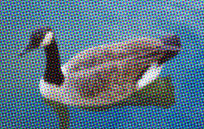RASTER IMAGE RESOLUTION ONLINE:
TYPICALLY 72 OR 96 DPI
When a raster image is placed on a website, the designer specifies the width and depth in terms of pixels. While 72 dpi is the default standard for Macintosh systems and 96 dpi is the Windows benchmark, what each website visitor sees depends on both the device and the software used to access the content. The choices of individual viewers introduce yet another set of variables.
While default monitor settings are within close range of Macintosh and Windows standards, users can change these configurations. A laptop screen that measures 13 x 8 inches can be configured to fill that space with 1024 x 768 pixels, 1280 x 800 pixels, or a number of other alternative settings. Browsers and other applications have zoom functions. Phones and other hand-held devices pack high-resolution capabilities into small screens, then allow users to magnify at will.
Given these variables, web designers have limited control over the physical size of a raster image as it will appear on a user's screen. Resolution per sé is generally not a problem. The challenge in online work is to make certain that the pixel dimensions for a particular image are sufficient so that it can be clearly discerned when viewed on a range of typical computer monitors and cellular phones.
Serious problems arising from insufficient resolution more often surface in the domain of print. The most common error begins with the assumption that a particular image — used online at 72 or 96 dpi — can also be placed at similar scale in a print project. Here, mistakes involving resolution can become much more troublesome. Whereas images placed online can be endlessly tweaked to improve their appearance, there's no such lattitude in a job reproduced at considerable expense on a commercial printing press.
PROFESSIONAL PRINTING REQUIRES
HIGHER RESOLUTION: IDEALLY 300 DPI
A computer monitor can produce millions of individual colors by mixing red, green, and blue light. Increments of 256 levels are available for each of the three. But a printing press must create a large range of colors from only a limited palette of inks. In order to make a gray color that is 50% black, the printing device lays down a dot that  is 100% black, but that dot is situated on a small field that is 50% uncovered. This technique, called halftoning, "tricks" the eye into seeing the desired gray color, as part of what looks like a continuous transition of color.
is 100% black, but that dot is situated on a small field that is 50% uncovered. This technique, called halftoning, "tricks" the eye into seeing the desired gray color, as part of what looks like a continuous transition of color.
Examine a printed piece under a magnifying glass, and you can see this effect. The dots are visible without magnification in newspapers, which use a relatively coarse linescreen, a grid that divides the image into small regions for each halftone dot. Newspapers typically use a linescreen of 85 lpi (lines per inch). 133 lpi is common for commercial offset printers, and 150 lpi is used in higher quality presses.
A linescreen knocks out some of the photo's detail. But so long as enough visual information is preserved, the human brain fills in the gaps to interpret a continuous picture. If the resolution of the image is at least twice the linescreen, the visual detail will be sufficient to turn this optical trick. Thus effective resolution of 300 dpi has become a benchmark, because it is double the 150 lpi linescreen associated with high-quality printing.